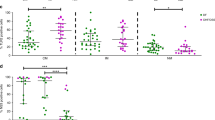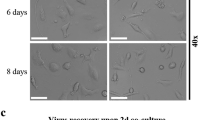Abstract
Toscana virus (TOSV) is a Phlebovirus responsible for human neurological infections in endemic Mediterranean areas. The main viral target is the central nervous system, with viremia as a way of dissemination throughout the host. This study was aimed at understanding the spread of TOSV in the host by identifying the cell population infected by the virus and the vehicle to the organs. In vivo studies provided evidence that endothelial cells are infected by TOSV, indicating their potential role in the diffusion of the virus following viremic spread. These results were further confirmed in vitro. Human peripheral mononuclear blood cells were infected with TOSV; only monocyte-derived dendritic cells were identified as susceptible to TOSV infection. Productive viral replication was then observed in human monocyte-derived dendritic cells (moDCs) and in human endothelial cells by recovery of the virus from a cell supernatant. Interleukin-6 was produced by both cell types upon TOSV infection, mostly by endothelial cells, while moDCs particularly expressed TNF-α, which is known to induce a long-lasting decrease in endothelial cell barrier function. These cells could therefore be implicated in the spread of the virus in the host and in the infection of tissues that are affected by the disease, such as the central nervous system. The identification of in vitro and in vivo TOSV cell targets is an important tool for understanding the pathogenesis of the infection, providing new insight into virus–cell interaction for improved knowledge and control of this viral disease.





Similar content being viewed by others
References
Baldelli F, Ciufolini MG, Francisci D, Marchi A, Venturi G, Fiorentini C, Luchetta ML, Bruto L, Pauluzzi S (2004) Unusual presentation of life-threatening Toscana virus meningoencephalitis. Clin Infect Dis 38:515–520
Bell D, Young JW, Banchereau J (1999) Dendritic cells. Adv Immunol 72:255–324
Charrel RN, Gallian P, Navarro-Mari JM, Nicoletti L, Papa A, Sánchez-Seco MP, Tenorio A, de Lamballerie X (2005) Emergence of Toscana virus in Europe. Emerg Infect Dis 11:1657–1663
Charrell RN, Bichaud L, De Lamballerie X (2012) Emergence of Toscana virus in the Mediterranean area. World J Virol 1:135–141
Clark IA (2007) The advent of the cytokine storm. Immunol Cell Biol 85:271–273
Combes V, Grau GE (2006) Cytokines in defence and pathology of the CNS p. 243–267. In: Ransohoff RM, Benveniste EN (eds), Cytokines and the CNS. CRC press
Cusi MG, Gori Savellini G, Terrosi C, Di Genova G, Valassina M, Valentini M, Bartolommei S, Miracco C (2005) Development of a mouse model for the study of Toscana virus pathogenesis. Virology 333:66–73
Cusi MG, Gori Savellini G, Zanelli G (2010) Toscana virus epidemiology: from Italy to beyond. Virol J 4:22–28
Denizot M, Neal JW, Gasque P (2012) Encephalitis due to emerging viruses: CNS innate immunity and potential therapeutic targets. J Infect 65:1–16
Dionisio D, Valassina M, Ciufolini MG, Vivarelli A, Esperti F, Cusi MG, Marchi A, Mazzoli F, Lupi C (2001) Encephalitis without meningitis due to sandfly fever virus serotype Toscana. Clin Infect Dis 32:1241–1248
Dropulic B, Masters CL (1990) Entry of neurotropic arboviruses into the central nervous system: an in vitro study using mouse brain endothelium. J Infect Dis 161:685–691
Gori Savellini G, Weber F, Terrosi C, Habjan M, Martorelli B, Cusi MG (2011) Toscana virus induces interferon although its NSs protein reveals antagonistic activity. J Gen Virol 92:71–79
Hemmersbach-Miller M, Parola P, Charrel RN, Durand J, Brouqui P (2004) Sandfly fever due to Toscana virus: an emerging infection in southern France. Eur J Intern Med 15:316–317
Lozach PY, Mancini R, Bitto D, Meier R, Oestereich L, Överby AK, Pettersson RF, Helenius A (2010) Entry of Bunyaviruses into mammalian cells. Cell Host Microbe 7:488–499
Lozach PY, Kühbacher A, Meier R, Mancini R, Bitto D, Bouloy M, Helenius A (2011) DC-SIGN as a receptor for Phleboviruses. Cell Host Microbe 10:75–88
Monaco C, Andreakos E, Young S, Feldmann M, Paleolog E (2002) T-cell mediated signaling to vascular endothelium: induction of cytokines, chemokines, and tissue factor. J Leukoc Biol 71:659–668
Navarro-Marí JM, Palop-Borrás B, Pérez-Ruiz M, Sanbonmatsu-Gámez S (2011) Serosurvey study of Toscana virus in domestic animals, Granada, Spain. Vector Borne Zoonotic Dis 11:583–587
Prazma CM, Tedder TF (2008) Dendritic cell CD83: a therapeutic target or innocent bystander? Immunol Lett 115:1–8
Prazma CM, Yazawa N, Fujimoto Y, Fujimoto M, Tedder TF (2007) CD83 expression is a sensitive marker of activation required for B cell and CD4+ T cell longevity in vivo. J Immunol 179:4550–4562
Prechtel AT, Turza NM, Theodoridis AA, Steinkasserer A (2007) CD83 knockdown in monocyte-derived dendritic cells by small interfering RNA leads to a diminished T cell stimulation. J Immunol 178:5454–5464
Ranaldi R, Goteri G, Biagetti S, Cusi MG, Rossini S (2011) Histological description of the lymphadenopathy related to Toscana virus infection. Report of a case. Pathol Res Pract 207:197–201
Sahni SK (2007) Endothelial cell infection and hemostasis. Thromb Res 119:531–549
Sanbonmatsu-Gámez S, Pérez-Ruiz M, Palop-Borrás B, Navarro-Marí JM (2009) Unusual manifestation of Toscana virus infection, Spain. Emerg Infect Dis 15:347–348
Taylor KG, Peterson KE (2014) Innate immune response to La Crosse virus infection. J Nurovirol 20:150–156
Tini P, Belmonte G, Toscano M, Miracco C, Palumbo S, Pastina P, Battaglia G, Nardone V, Butorano MA, Masucci A, Cerase A, Pirtoli L (2015) Combined epidermal growth factor receptor and beclin 1 autophagic protein expression analysis identifies different clinical presentations, responses to chemo- and radiotherapy, and prognosis in glioblastoma. Biomed Res 2015:208076
Valassina M, Cusi MG, Valensin PE (2003a) A Mediterranean arbovirus: the Toscana virus. J Neurovirol 9:577–583
Valassina M, Valentini M, Pugliese A, Valensin PE, Cusi MG (2003b) Serological survey of Toscana virus infections in a high-risk population in Italy. Clin Diagn Lab Immunol 10:483–484
Valbuena G, Walker DH (2006) The endothelium as a target for infections. Annu Rev Pathol 1:171–198
Visseren FL, Verkerk MS, Bouter KP, Diepersloot RJA, Erkelens DW (1999) Interleukin-6 production by endothelial cells after infection with influenza virus and cytomegalovirus. J Lab Clin Med 134:623–630
Zanelli G, Bianco C, Cusi MG (2013) Testicular involvement during Toscana virus infection: an unusual manifestation? Infection 41:735–736
Acknowledgments
We would like to thank Prof. A. De Luca for his helpful suggestions.
Author information
Authors and Affiliations
Corresponding author
Ethics declarations
Conflict of interest
The authors, Maria Grazia Cusi, Claudia Gandolfo, Chiara Terrosi, Gianni Gori Savellini, Giuseppe Belmonte and Clelia Miracco, declare that they have no conflict of interest.
Rights and permissions
About this article
Cite this article
Cusi, M.G., Gandolfo, C., Terrosi, C. et al. Toscana virus infects dendritic and endothelial cells opening the way for the central nervous system. J. Neurovirol. 22, 307–315 (2016). https://doi.org/10.1007/s13365-015-0395-2
Received:
Revised:
Accepted:
Published:
Issue Date:
DOI: https://doi.org/10.1007/s13365-015-0395-2





